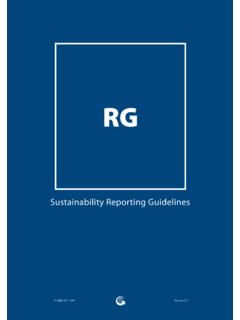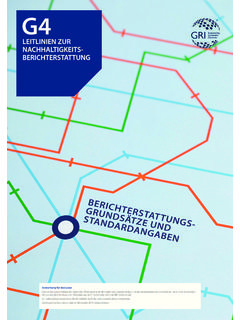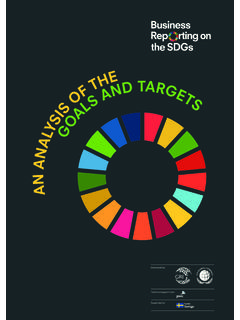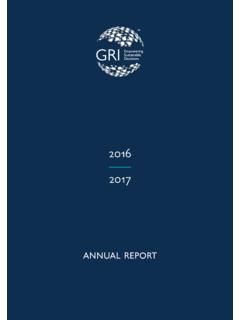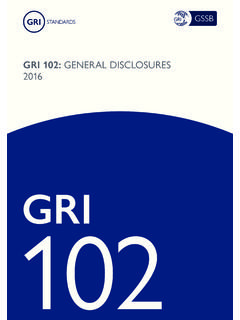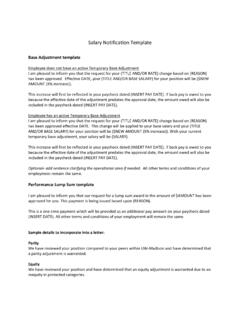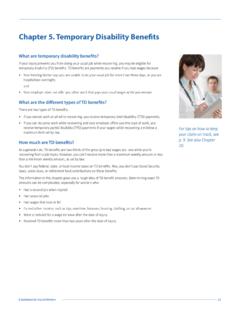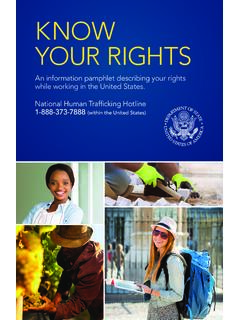Transcription of GRI 401: EMPLOYMENT 2016 - Global Reporting Initiative
1 gri 401 : EMPLOYMENT 2016 GRI 4012 gri 401 : EMPLOYMENT 2016 ContentsIntroduction 3 gri 401 : EMPLOYMENT 51. Management approach disclosures 52. Topic-specific disclosures 7 Disclosure 401-1 New employee hires and employee turnover 7 Disclosure 401-2 Benefits provided to full-time employees that are not provided to temporary or part-time employees 8 Disclosure 401-3 Parental leave 9 Glossary 10 References 12 ResponsibilityThis Standard is issued by the Global Sustainability Standards Board (GSSB). Any feedback on the GRI Standards can be submitted for the consideration of the GSSB. ScopeGRI 401: EMPLOYMENT sets out Reporting requirements on the topic of EMPLOYMENT . This Standard can be used by an organization of any size, type, sector or geographic location that wants to report on its impacts related to this referencesThis Standard is to be used together with the most recent versions of the following 101: FoundationGRI 103: Management Approach GRI Standards GlossaryIn the text of this Standard, terms defined in the Glossary are dateThis Standard is effective for reports or other materials published on or after 1 July 2018.
2 Earlier adoption is this Standard Note: This document includes hyperlinks to other Standards. In most browsers, using ctrl + click will open external links in a new browser window. After clicking on a link, use alt + left arrow to return to the previous 401: EMPLOYMENT 2016A. Overview This Standard is part of the set of GRI Sustainability Reporting Standards (GRI Standards). These Standards are designed to be used by organizations to report about their impacts on the economy, the environment, and GRI Standards are structured as a set of interrelated, modular standards. The full set can be downloaded at There are three universal Standards that apply to every organization preparing a sustainability report:GRI 101: FoundationGRI 102: General DisclosuresGRI 103: Management Approach An organization then selects from the set of topic-specific GRI Standards for Reporting on its material topics.
3 These Standards are organized into three series: 200 (Economic topics), 300 (Environmental topics) and 400 (Social topics).Each topic Standard includes disclosures specific to that topic, and is designed to be used together with GRI 103: Management Approach, which is used to report the management approach for the Using the GRI Standards and making claims There are two basic approaches for using the GRI Standards. For each way of using the Standards there is a corresponding claim, or statement of use, which an organization is required to include in any published materials. 1. The GRI Standards can be used as a set to prepare a sustainability report that is in accordance with the Standards. There are two options for preparing a report in accordance (Core or Comprehensive), depending on the extent of disclosures included in the report. An organization preparing a report in accordance with the GRI Standards uses this Standard, gri 401 : EMPLOYMENT , if this is one of its material Selected GRI Standards, or parts of their content, can also be used to report specific information, without preparing a report in accordance with the Standards.
4 Any published materials that use the GRI Standards in this way are to include a GRI-referenced 401: EMPLOYMENT is a topic-specific GRI Standard in the 400 series (Social topics).GRI 101: Foundation is the starting point for using the GRI Standards. It has essential information on how to use and reference the Section 3 of GRI 101: Foundation for more information on how to use the GRI Standards, and the specific claims that organizations are required to include in any published materials. GRI 103 GRI 102 Topic-specificStandardsUniversal StandardsStarting point for using the GRI StandardsGRI 101 FoundationGeneral DisclosuresManagement ApproachTo report contextual information about an organizationTo report the management approach for each material topicSelect from these to report specific disclosures for each material topicGRI 300 EnvironmentalGRI 400 SocialGRI 200 EconomicFigure 1 Overview of the set of GRI Standards4 gri 401 : EMPLOYMENT 2016C.
5 Requirements, recommendations and guidance The GRI Standards include: Requirements. These are mandatory instructions. In the text, requirements are presented in bold font and indicated with the word shall . Requirements are to be read in the context of recommendations and guidance; however, an organization is not required to comply with recommendations or guidance in order to claim that a report has been prepared in accordance with the These are cases where a particular course of action is encouraged, but not required. In the text, the word should indicates a recommendation. Guidance. These sections include background information, explanations and examples to help organizations better understand the organization is required to comply with all applicable requirements in order to claim that its report has been prepared in accordance with the GRI Standards. See GRI 101: Foundation for more Background context In the context of the GRI Standards, the social dimension of sustainability concerns an organization s impacts on the social systems within which it operates.
6 gri 401 addresses the topic of EMPLOYMENT . This includes an organization s approach to EMPLOYMENT or job creation, that is, an organization s approach to hiring, recruitment, retention and related practices, and the working conditions it provides. gri 401 also covers the EMPLOYMENT and working conditions in an organization s supply EMPLOYMENT relationship is a legal relationship between a worker and an organization that confers rights and obligations to both parties. This relationship is usually the means for determining whether EMPLOYMENT or labor law is applicable or whether commercial law is concepts are covered in key instruments of the International Labour Organization, the Organisation for Economic Co-operation and Development, and the United Nations: see disclosures in this Standard can provide information about an organization s impacts related to EMPLOYMENT , and how it manages of work are also covered in detail in other Standards: GRI 402: Labor/Management Relations GRI 403: Occupational Health and Safety GRI 404: Training and Education GRI 405: Diversity and Equal Opportunity GRI 406: Non-discriminationIn addition, Disclosure 102-8 in GRI 102.
7 General Disclosures requires information on employees and other workers performing an organization s activities, such as the total number of employees by EMPLOYMENT contract (permanent and temporary ), by gender. 5 gri 401 : EMPLOYMENT 2016 This Standard includes disclosures on the management approach and topic-specific disclosures. These are set out in the Standard as follows: Management approach disclosures (this section references GRI 103) Disclosure 401-1 New employee hires and employee turnover Disclosure 401-2 Benefits provided to full-time employees that are not provided to temporary or part-time employees Disclosure 401-3 Parental leaveReporting The Reporting organization shall report its management approach for EMPLOYMENT using GRI 103: Management 401:Employment1. Management approach disclosuresManagement approach disclosures are a narrative explanation of how an organization manages a material topic, the associated impacts, and stakeholders reasonable expectations and interests.
8 Any organization that claims its report has been prepared in accordance with the GRI Standards is required to report on its management approach for every material topic, as well as Reporting topic-specific disclosures for those , this topic-specific Standard is designed to be used together with GRI 103: Management Approach in order to provide full disclosure of the organization s impacts. GRI 103 specifies how to report on the management approach and what information to 401: EMPLOYMENT 2016 GuidanceGuidance for clause or practices covering the relationships under which work is performed for an organization can include recognized EMPLOYMENT relationships, the use of employees of other organizations (such as workers supplied by agencies), and the extent to which work is performed on a temporary or part-time basis. A description of policies and practices can include policies and practices with respect to discrimination, compensation, promotion, privacy, human resource development and industrial taking place within an appropriate institutional and legal framework usually entails a recognizedemployment relationship with an identifiable and legally recognized of work can include compensation, working time, rest periods, holidays, disciplinary and dismissal practices, maternity protection, the workplace environment, and occupational health and safety.
9 They can also include the quality of living accommodations where provided, and welfare matters, such as safe drinking water, canteens and access to medical remunerated work is work where wages and compensation for a standard working week, excluding overtime, meet legal and industry minimum standards, and are sufficient to meet the basic needs of workers and their families, and to provide them with some discretionary income. Actions taken to address situations where work is inadequately remunerated can include: dialogue with suppliers regarding the relationship of the prices paid to suppliers and the wages paid to workers; changes to an organization s procurement practices; support for collective bargaining to determine wages; determining the extent that overtime is used, whether it is mandatory, and whether it is compensated at a premium The Reporting organization should describe: its policies or practices covering the relationships under which work is performed for the organization; actions taken to determine and address situations where work undertaken within its supply chain does not take place within appropriate institutional and legal frameworks.
10 Actions taken to determine and address situations where persons working for suppliers are not provided the social and labor protection that they are entitled to receive by national labor law; actions taken to determine and address situations where working conditions in its supply chain do not meet international labor standards or national labor law; actions taken to determine and address situations where work undertaken in its supply chain is inadequately remunerated; actions taken to determine and address situations of disguised EMPLOYMENT relationships where workers in its supply chain are falsely considered to be self-employed or where there is no legally recognized employer; actions taken to determine and address situations where work undertaken in its supply chain that is performed at home is not subject to legally recognized approach disclosures Continued7 gri 401 : EMPLOYMENT When compiling the information specified in Disclosure 401-1, the Reporting organization shall use the total employee numbers at the end of the Reporting period to calculate the rates of new employee hires and employee 401-1 New employee hires and employee turnover2.
